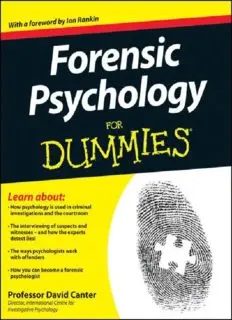
Forensic Psychology For Dummies PDF
Preview Forensic Psychology For Dummies
® Forensic Psychology For Dummies Visit www.dummies.com/cheatsheet/forensicpsychologyuk to view this book's cheat sheet. Table of Contents Introduction About This Book Conventions Used in This Book What You’re Not to Read Foolish Assumptions How This Book Is Organised Part I: Nailing Forensic Psychology: A Moving Target Part II: Helping the Police Solve Crimes Part III: Measuring the Criminal Mind Part IV: Viewing Psychology in Court Part V: Helping and Treating Offenders Part VI: The Part of Tens Icons Used in This Book Where to Go from Here Part I: Nailing Forensic Psychology: A Moving Target Chapter 1: Discovering the Truth about Forensic Psychology Grasping What Forensic Psychology Is Not Finding out that forensic psychology isn’t forensics Distinguishing forensic psychology from psychiatry Recognising What Forensic Psychology Is Step 1: Crime starts with a criminal Step 2: Reporting of the crime Step 3: Investigation gets underway Step 4: An offender is apprehended Step 5: Conviction for a crime Step 6: After the trial Reviewing the origins of forensic psychology Examining the Building Blocks of Forensic Psychology Experimenting Studying in the field Assessing and measuring Studying individual cases Getting theoretical Professional ethics Working with Others: People and Places That Forensic Psychologists Encounter In the courts With victims In prisons, ‘special hospitals’ and correctional institutions With the police Chapter 2: Exploring the World of the Criminal Defining Criminals and Crimes Getting caught (or not) Careering towards criminality Identifying different forms of similar crimes Committing a Crime: What Leads Someone to Break the Law Giving birth to criminals? Keeping bad company Abusing substances Passing it on in the blood Thinking about crime Getting personal with the personality of many criminals Investigating Mental Disorder and Crime Enjoying the urge to hurt: Sadism Loving yourself: Narcissism Sitting on the fence: Borderline personality disorder Suffering psychosis Understanding Why Not Everyone Is a Criminal Factoring in protective factors Lacking the opportunity Fearing being caught Aging: ‘I’m too old for all this!’ Chapter 3: Providing Expert Evidence: Forensic Psychology and the Law Understanding That Legal Systems Vary Worldwide Facing up to an opponent: The adversarial system Keeping things brief in court: The inquisitorial system Examining the US system: Constitution, federal and state laws Considering the implications for forensic expertise Using Your Experience and Knowledge: What Is an Expert Witness? Being called as an expert in criminal proceedings Appearing as an expert in civil proceedings Keeping Your Lips Sealed: What an Expert Can’t Comment On Staying within your competence Avoiding the ultimate question Remaining unprejudiced Detailing the Dangers: Ensuring Trial by Jury and not Trial by Expert Accepting the restrictions of being an expert in court Criticising the role of forensic psychology experts in court Part II: Helping the Police Solve Crimes Chapter 4: Interviewing Witnesses and Victims Understanding the Nature of Interviews: Why Are You Asking Me That? Interviewing and its connection to other sources of information Managing the process: Interviews as conversations Remembering That Memory Can Mislead Recalling past events Forgetting: Why do people fail to remember? Facing up to false memories Assisting Witnesses and Victims to Remember Letting someone speak: The cognitive interview Interviewing suspects Dealing with false confessions Using investigative hypnosis Helping children tell what happened Looking Into Eyewitness Testimony Assessing eyewitness accuracy Understanding unconscious transference Minimising bias: Good practice recommendations Chapter 5: Exposing Liars and Detecting Deception Understanding the Nature of Lying Discovering the difficulties of successful deception Summarising why detecting deception is so difficult Detecting Lies: Some Attempted Procedures Using physiological approaches Observing carefully: Behavioural approaches Studying semantic assessment Looking at legal approaches Ways in Which Lying Is Used to Commit Crime Combating insurance fraud Discovering false allegations Tackling extortion Interviewing Suspects to Sort Truth from Lies Dealing with false confessions Encountering the IEE approach in the US Interrogating suspects Examining Documents to Help Solve Crimes Entering the world of document experts Chapter 6: Profiling Offenders and Distinguishing the Types of Crimes They Commit Investigating ‘Offender Profiling’ Jack the Ripper The mad bomber of New York The railway murderer Demythologising ‘profiling’ Delving Into Investigative Psychology Following the investigative cycle Profiling equations Facing the challenge of contingencies Hearing the stories people tell themselves: Criminal narratives Locating offenders geographically Distinguishing between Crimes Dealing with property crimes Working on violent crimes Questioning Whether This Chapter Should be Published Chapter 7: Understanding Victims of Crime and Their Experiences Suffering at the Hands of Criminals: Who Become Victims of Crime? Identifying the victims Breaking the cycle: Criminals becoming victims and victims becoming criminals Establishing who’s at risk of repeat victimisation Understanding the Effects of Crimes on Victims Viewing burglary as violation Experiencing uncertainty: The worst part is not knowing Suffering from the trauma of rape Examining the effects of physical abuse on children Identifying and handling traumatic brain injury Assessing the Psychological Effects of a Crime on a Victim Dealing with post-traumatic stress disorder Offering restorative justice Chapter 8: Preventing Crime: Problems, Processes and Perseverance Understanding the Difficulties of Preventing Crime Keeping pace with the evolution of crime Asking whether prison works Getting tough on the causes of crime Succeeding only in displacing crime Examining Ways to Prevent (or at Least Combat) Crime Making crime more difficult Ensuring that crime doesn’t pay Disrupting criminal careers Changing the law Using Psychological Understanding to Combat Specific Types of Crime Negotiating in hostage situations Tackling criminal street gangs Using psychology against criminal networks Part III: Measuring the Criminal Mind Chapter 9: Measuring, Testing and Assessing the Psychology of Offenders Introducing Psychological Measurement Getting to Grips with Psychological Measurement Methods Talking with people: Interview protocols Saying what you see: Projective techniques Assessing intelligence and skills through performance Standardising psychological tests Identifying the Different Aspects That Measurement Methods Assess Thinking ability: Cognitive tests Discerning a person’s personality Discovering beliefs: Attitude scales Classifying mental disorders Testing the Tests Aiming for test reliability
